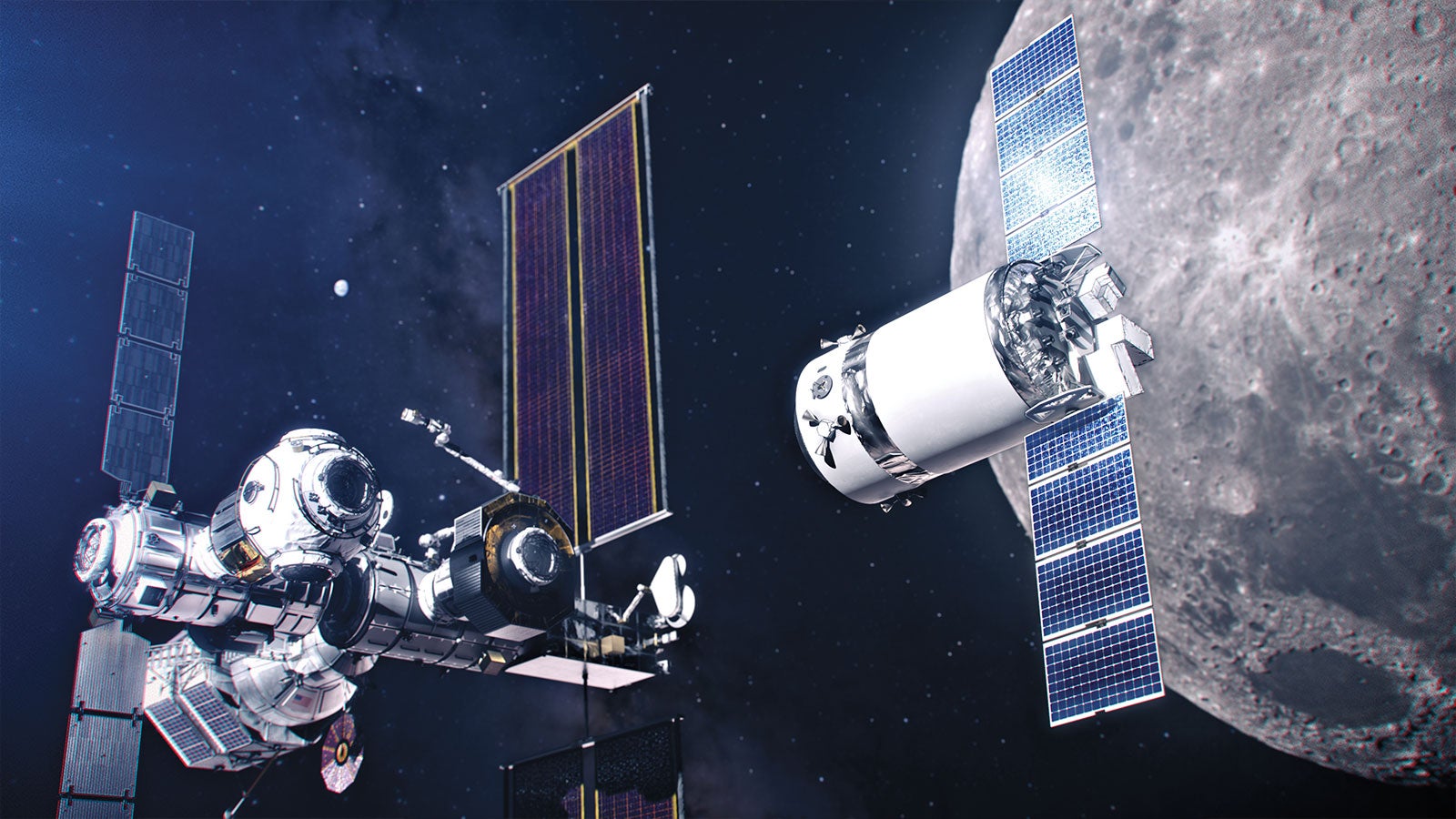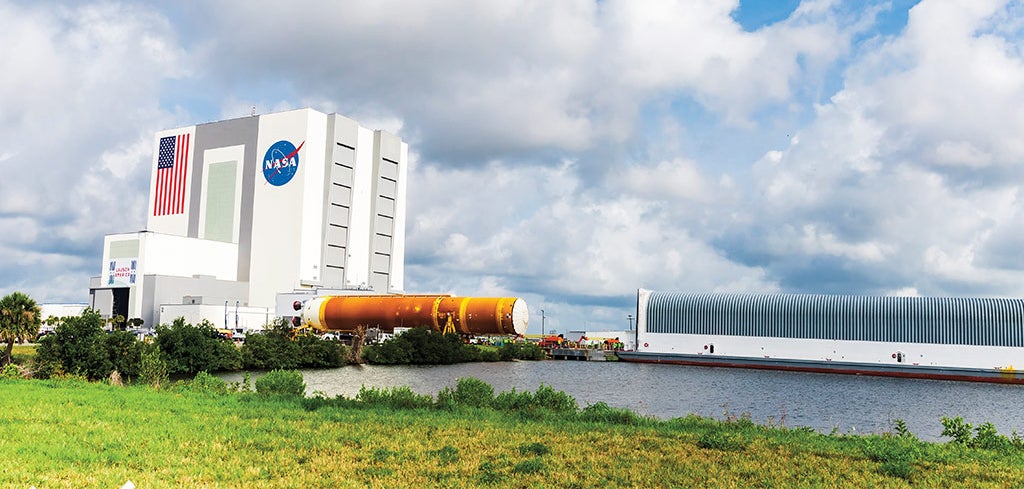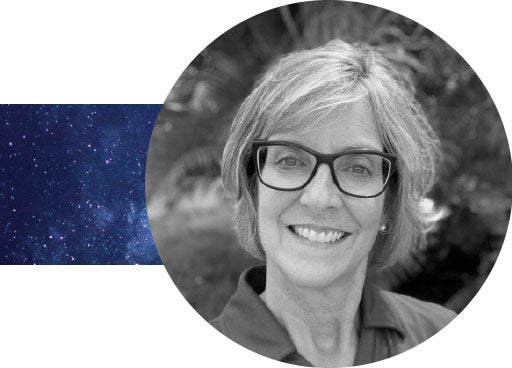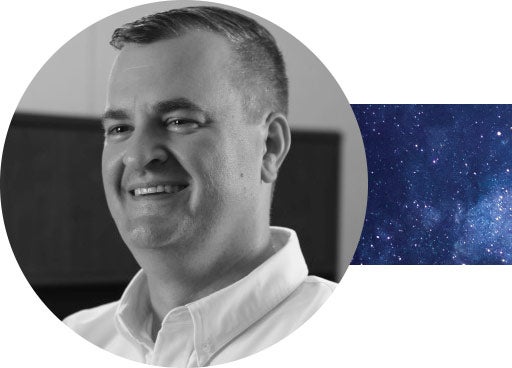
Gateway to the Galaxy
Summer 2021 | By Nicole Dudenhoefer ’17
Jenny Lyons ’92MS recalls watching shuttle launches with her father when she was in high school and asking him, “Why are there no women in the control room?” He didn’t know, but what he said next changed her life: “Why don’t you do something about that?”
Three decades later, Lyons is now the deputy manager for NASA’s Gateway Deep Space Logistics — an outpost that will orbit the moon and is a part of the Artemis program, which aims to send the first woman and person of color to the moon by 2024. Gateway will be a crucial element for the next wave of space exploration that will not only establish a sustainable presence on the moon but also play a major role in landing astronauts on Mars in the 2030s.
“The future of humanity depends on the efforts that we’re doing,” says Lyons. “We’ve been demonstrating how to evolve humans off of Earth to live and work in space continuously at the International Space Station in low-Earth orbit, but I think this is the natural evolution that takes us out farther. Being part of building the highway that’s taking us out into space to live is really awesome.”
In Greek mythology, Artemis is the goddess of the moon and twin sister of the sun god, Apollo. The current program name mirrors the Apollo program from the late ’60s and early ’70s when the United States landed 12 men, including Neil Armstrong, on the moon. The Artemis mission marks the United States’ return to moon landings since astronaut Eugene Cernan left his footprints on the surface in 1972.
An Intentional Design
Mark Wiese ’11MS, manager for Gateway Deep Space Logistics and one of 20 Knights on the project, has no doubt NASA can do it. The technology has been there since the last century. The biggest obstacle, according to Wiese, comes down to something far less scientific — public approval.
“NASA knows how to do this,” says Wiese. “The problem has been communicating to our stakeholders — the general public who funds us — that doing this is the right thing to do for our country given the competing economic, environmental and public health priorities right now. Investing in what NASA is doing will eventually open up ways for us to live differently on Earth and advance technologies for all of us.”
Decades ago, the Apollo program, which cost about $283 billion when adjusted for inflation, came to an end when the government could no longer afford to fund the program. NASA estimates the Artemis program will cost $86 billion through the 2025 fiscal year, with Gateway accounting for about $3.8 billion of that cost. To avoid past funding issues, NASA is partnering on certain aspects of the projects with the Canadian Space Agency, European Space Agency, Japanese Aerospace Exploration Agency and American commercial companies.
“NASA is the research and development leg of the people of the United States, so when the government invests in NASA, it buys down the risk for things that commercial companies can’t [afford] the resources for,” says Wiese. “We have found ways to let space be a platform for new ideas, companies, entrepreneurial ways of doing things and mobility that is beyond the reach of what we initially thought.”
Gateway is comprised of three pieces: The Power and Propulsion Element (PPE) will fuel its orbit and is being managed out of NASA’s Glenn Research Center in Ohio. The Habitation and Logistics Outpost (HALO) will provide housing for astronauts as well as space to store supplies and conduct experiments. It is being developed by Northrop Grumman and will be managed out of the Johnson Space Center in Houston. And the Human. Landing Systems (HLS) that astronauts will use to reach the moon’s surface was awarded in April to SpaceX.
PPE and HALO will come together at Kennedy Space Center under the supervision of the Deep Space Logistics team, led by Wiese and Lyons. After these two elements are launched in 2024, HLS will join them closer to the moon landing mission. Deep Space Logistics is also responsible for delivering the supplies needed for Artemis missions to Gateway prior to the crew arriving, which differs from previous moon landing missions.
With any proposed change comes resistance. Critics of Gateway note that the Apollo program didn’t require an orbiting outpost, and that NASA made it to the moon just fine without a pit stop. But Wiese makes the comparison to tourists visiting Central Florida. Their first stop isn’t the theme parks. It’s a hotel or resort from which they can visit all the attractions Orlando has to offer.
“We didn’t have Gateway when we had Apollo, but Apollo was limited to where on the moon we could go,” Wiese says. “Gateway gives us a way to access any point on the surface of the moon … It’s humbling to sit there and realize we’re standing on the shoulders of all the people behind us.”
The Right Team at the Right Facility
NASA has 18 major centers and facilities across the nation, but Kennedy Space Center (KSC) remains the top spot for launches with more than 90 commercial partners on-site. It’s one reason Associate Manager for Integration and Analysis Johnny Nguyen ’01 ’05MBA says it makes sense for Gateway’s Deep Space Logistics to be based there.
“For Deep Space Logistics, we’re delivering all this stuff to the lunar vicinity, and it all has to come together at the very end,” Nguyen says. “Some supplies, like clothing, you could pack years ahead of time, and some cargo supplies, like batteries, have to be packed at the very last second. Having all of the hardware and supplies, the different missions and projects happening at Kennedy Space Center, and the deep experience of the people here creates a really strong community to draw upon. So it’s a really vibrant center.”
KSC was selected as the hub for Gateway specifically because of the employees who work there. Nearly 30% of KSC employees graduate from UCF, which has long been the top supplier of aerospace and defense graduates in the nation. For Nguyen this includes a bachelor’s in mechanical engineering that gives him technical insight, as well as a master’s in business administration that helps him manage the contracts and finances, which are a major part of Deep Space Logistics’ work.
“The team at KSC has vast experience executing commercial contracts for launch services and with the commercial crew program, so it’s a natural fit to bring that expertise to Deep Space Logistics,” says Dan Hartman, Gateway program manager, based at Johnson Space Center. “Mark and Jenny have provided exceptional leadership for Deep Space Logistics efforts, constantly challenging our entire team to maintain focus on simplicity and commercial innovation.”
Although in different cohorts, Lyons and Wiese pursued master’s degrees in industrial engineering at UCF through the Professional Engineering Management program, which is one of several degree programs at UCF that hundreds of KSC employees have benefited from. With bachelor’s degrees in aerospace engineering from other universities, Lyons and Wiese’s master’s degree studies at UCF focused more on management aspects related to engineering.
“They offered us classes outside of our traditional bachelor’s because understanding aspects of the business including human resources were not anything we had exposure to,” Lyons says. “People from all different organizations at [KSC], such as the chief financial officer organization, were also represented in this program and got the technical classes while we got some of the business classes, and all of us were stronger for it.”
Tim Kotnour, director of UCF’s Professional Engineering Management program since 2008, says Lyons and Wiese are natural leaders who have enhanced their core leadership and management skills through their studies and work experience. In the classroom, Kotnour says Wiese was a forward thinker who pushed those around him to produce greater outcomes. While Lyons didn’t take any courses with Kotnour, the two have worked together for more than 23 years, and he says she has advanced the strategic evolution of KSC while using a servant leadership approach to mentor other women in the aerospace industry.
“Mark and Jenny have the unique ability to balance focus on performance, process and people to translate the big-picture strategy into specific action,” says Kotnour, Lockheed Martin St. Laurent Professor of industrial engineering.
“Their presence in the room makes a difference. They bring calmness to situations while also driving accountability, which is a tough balance for other leaders — but they do this well. Folks follow their lead not because of their formal positions, but because of the people they are.”
Testing Tech Innovation
With a range of skill sets, the Deep Space Logistics team is able to leverage every member’s strengths to develop innovative solutions for challenges with fuel sources, propulsion methods and radiation protection — all of which have the potential to advance life off and on Earth.
So far, humans have only been able to explore about 5% of the moon. Accessing more of the lunar surface will allow scientists to take advantage of a discovery made in the past decade: millions of tons of water ice found beneath the moon’s surface that can be mined and split into liquid hydrogen and oxygen for rocket fuel. The water can also be consumed by astronauts and used to maintain temperatures of spacecrafts.
“Now that we have [liquid] hydrogen and oxygen as another fuel source, we can use that to power deep space travel, so we don’t have to bring everything from Earth,” Wiese says. “Also, locating an energy source in space is a great way for us to look at continuing to reduce our energy consumption on Earth, so we can continue to protect our own planet.”
While liquid hydrogen creates a chemical propulsion that propels spacecrafts, such as Gateway, into space, NASA plans to test the ability of a different fuel source — the sun — to actually power the lunar outpost’s orbit. Once the agency is ready to send astronauts to Mars, Gateway will be programmed to complete the six-to-nine-month journey to the red planet — with abort capabilities in case anything goes wrong.
“The backbone of Gateway is demonstrating new solar electric propulsion technologies, which is the utmost importance for us to go to Mars since we can’t bring huge fuel tanks with us,” says Wiese. “Solar electrical propulsion isn’t as strong of a push, but … it’s more sustainable and can actually tug heavier masses over longer periods of time.”
While the sun will help propel spaceships farther, the powerful energy force becomes increasingly problematic for hardware and astronauts the deeper they go into space, says Dawn Trout ’12PhD, element architecture senior discipline lead for Deep Space Logistics.
NASA has developed reboot programs, structures and spacesuits to protect against radiation. But the ability to conduct experiments hundreds of thousands of miles from Earth will allow the agency to develop better protection methods as they prepare to travel almost 200 million miles to Mars. And it will provide commercial companies with insight on how to better shield humankind.
“Because the technologies developed for NASA are developed by the U.S. government, a lot of time the space agency’s intellectual property becomes available to commercial companies that produce spinoffs,” says Ray Lugo ’79, director of the Florida Space Institute and industrial engineering graduate. “Over time, we as humans get a lot of exposure to radiation from different kinds of activities, [from using our cellphones] to X-rays, MRIs and CAT scans. So developing those technologies for deep space travel will actually [help] protect humans [on Earth] during normal activities and medical procedures.”
While many of the technologies used for Gateway aren’t necessarily new, the way they’re being applied and modified showcases the subtle difference between invention and innovation. Having the vision and willingness to do things differently, to find better approaches to old problems and foresee emerging issues with new methods takes curious minds who remain inspired to rise beyond the call to action.
“My dad may have laid down the initial challenge, but it was my UCF education — along with many other opportunities provided to me by NASA — that has allowed me to pursue a career beyond my wildest dreams,” Lyons says. “After all, that’s what NASA was built to do — to inspire, create and achieve the seemingly impossible.”

Before returning to the moon in 2024, NASA must finalize everything on land, which recently required the space agency to ship the backbone of its tallest rocket from the Michoud Assembly Facility in New Orleans to Kennedy Space Center. Traveling on the Pegasus barge, the 212-foot Space Launch System’s core system will help propel supplies and astronauts to Gateway.
Header image and portraits courtesy of NASA.

